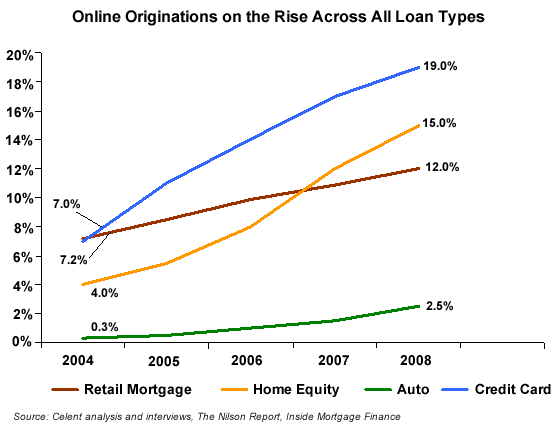Up Close and Personal with Online Lending
Abstract
Online originations are increasing across all loan types, and opportunities exist to blend peer-to-peer lending models with mainstream banking products.
Online lending has tremendous upside potential across all loan types. However, banks will need to execute exceedingly well to obtain market share, according to the new Celent report, . Competing in this market requires fully automating the lending process while ensuring tight integration between online and offline customer service channels. Lenders who cannot provide a streamlined and integrated user experience will fare poorly with their online initiatives. Online borrowers are increasingly tech-savvy (particularly repeat borrowers) and value the Internet for the time and money it can save them.
Direct lenders such as Quicken Loans, E-Loan, or ING Direct that offer transparent pricing and lower costs already account for over 27% of retail online mortgage originations and will continue to perform well. Leading brick-n-click lenders including Countrywide, Wells Fargo and Bank of America are also responding aggressively to the online opportunity and hold the dominant share of retail loan originations. The Internet has also given budding peer-to-peer lending companies such as Prosper, Zopa, or Circle Lending the impetus to capture some of the online lending upside.
"Customers expect to see additional benefits from choosing the online channel, such as the reduction or elimination of paper documents, the ability to track the status of their loan application in a comprehensive manner, faster processing and approval times resulting from streamlined back office operations, and ultimately lower prices," says Madhavi Mantha, co-author and senior analyst.
"Perhaps the ultimate example of just how intensely personal online lending has become is peer-to-peer lending. Its customers often view their financial activity as a means of self expression. For these individuals, the personalization of online lending has increasingly meant the ability to choose who they borrow from, who they lend to, and what level of risk they should take in investing their money as their own lender. P2P lenders have demonstrated that a growing consumer lending market exists," says Dan Schatt, co-author and senior analyst. In this report, Celent profiles companies and technology initiatives best positioned to deliver online lending successfully. Celent profiles bank and nonbank initiatives that are gaining traction and provides a glimpse as to how financial institutions and social lending services will come together in the next few years.

The 54-page report has 14 figures and 10 tables. A table of contents is available online.
Members of Celent's Retail Banking research service can download the report electronically by clicking on the icon to the left. Non-members should contact info@celent.com for more information.

